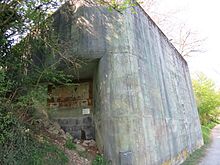Lock point Zurzach
The Zurzach blocking point was a border fortification of Border Brigade 5 of the Swiss Army . It extends on the left bank of the Rhine from the gravel group north of the thermal baths to the soda factory near Rekingen . Their works secured the crossing of the Rhine, the banks of the Rhine and at Zurzach-Bsetzi the Bruggerstrasse setzi over the Achenberg into the moated castle of Switzerland . It is considered a military historical monument of national importance.
history
The strategic importance of the Rhine and the conveniently located Rhine crossing at Bad Zurzach was recognized as early as Roman times . The natural river obstacle Rhine was used for the military security of the Roman Empire. The Helvetii were responsible as the Foederati for the Roman watch on the Rhine. When the system of securing the Rhine border left by Gaius Iulius Caesar proved to be inadequate in the long run, the Roman legions were sent to Aargau. Tiberius established the Roman military post of Vindonissa in AD 14 .
The Roman military camp at Zurzach existed from around 10 to 50 AD to protect the Rhine crossing of the Roman road from Vindonissa to Arae Flaviae . Valentinian I completed the fortification of the Rhine line in the 370s AD . During this time the construction of the Kirchlibuck-Sidelen "Tenedo" fort was built, which controlled the bridge built in AD 368 as an important part of the Neckar-Alb-Aare Roman road . In the Middle Ages, Mandach Castle served to secure the crossing of the Rhine.
During the Second World War , the Swiss border was fortified with great effort. Around 1935, the existing explosive devices were added to all Rhine bridges and anti-tank barriers were built. Machine gun bunkers (MG) were built along the banks of the Rhine to prevent enemy infantry forces from crossing over. An engineer-officer course in 1934 dealt with the possibilities of the priority fortification of the bridgehead at the Rhine crossing in Bad Zurzach. From 1936 to 1939, the seven objects at the Zurzach lockout were built by private construction companies. In Rietheim's Rheinboden, the bunkers at the foot of the Laubberg hill range ( Koblenz closure point ) were taken back and a rail obstacle was added. On August 29, 1939, soldiers of Grenz-Mitrailleur-Company IV / 252 of Grenzbrigade 5 moved into the bunkers in serious circumstances .
Lock point Zurzach
In 1936 the Rhine crossing was secured with an armored barricade at customs and from 1937 the infantry bunker "Brücke" (in the axis of the bridge) and the machine gun bunkers along the banks of the Rhine were built as a continuation of the Basel - Stein am Rhein bunker chain on the left bank of the Rhine :
- Infantry bunker "Rietheim-Schachen" A 4224: 2 Mg ⊙
- Infantry bunker "Rheinfeld" A 4223: 3 machine guns (MG) ⊙
- Infantry bunker «Kiesgrube Nord» A 4222: 2 Mg ⊙
- Infantry bunker «Kiesgrube Süd»: Infantry cannon (Ik) (broken off)
- Infantry bunker "Säge" A 4220: 2 Mg ⊙
- Infantry bunker "Burg / Berg" A 4221: 2xMg ⊙
- Infantry bunker "Brücke" A 4219: Ik, Mg ⊙
- Infantry bunker “Zurzach Bsetzi: Aegerten” A 4218: 24 mm tank canister 41 , 2 Lmg 25 ⊙
- Infantry bunker “Zurzach Bsetzi: Lusthüsli” A 4217: Ik, Mg ⊙
- All terrain armor obstacle «Zurzach Bsetzi» ⊙
- Infantry bunker «Soda» A 4216: Mg ⊙
- Street barricade "customs"
- Observer «Naziblick» (canceled)
- Observer «drip hole»
- Observer «Ratzloch»
Lock point Kaiserstuhl

From Zurzach to Kaiserstuhl, numerous bunkers had been built upstream on the bank:
- Infantry bunker “Rekingen-Sodafabrik” A 4213 ⊙
- Infantry bunker "Rekingen-Kreuzlibach" A 4212 ⊙
- Infantry bunker “Rekingen-Reckenden Kraftwerk” A 4211 ⊙
- Infantry bunker “Mellikon-Meienried” A 4210 ⊙
- Infantry bunker “Mellikon-Rheinzelg” A 4209 ⊙
- Infantry bunker “Mellikon-Tegerbach” A 4208 ⊙
- Infantry bunker “Rümikon-Wasseräcker” A 4207 ⊙
- Infantry bunker "Rümikon-Scheibenbuck" A 4206 ⊙
- Infantry bunker "Rümikon-Rieselbuck" A 4205 ⊙
- Infantry bunker "Rümikon-Sandgraben" A 4204: Mg ⊙
- Infantry bunker “Fisibach-Schwarzwasserstelz” A 4203: 2 Mg ⊙
- "Rümikon-Kesseläcker" shelter A 4202
- Infantry bunker A 4201 Siglistorf West ⊙
- Infantry bunker A 4200 Siglistorf Ost ⊙
- "Hägele" shelter A 5399
- Infantry bunker «Fisibach» A 5400: Mg ⊙
- Infantry bunker “Fisibach-Bleiche” A 5401: 2 Mg ⊙
- “Fisibach-Blöhliboden” shelter A 5402 ⊙
- Infantry bunker "Kaiserstuhl-Pumpenhaus" A 5403: 2 Mg ⊙
- "Weiach-Griesgraben" shelter A 5404: ⊙
- "Weiach-Griesgraben" shelter F 6010: ⊙
- Infantry bunker «Weiach-Griesgraben» A 5405: Mg ⊙
- Infantry bunker "Weiach-Sädelbach A 5406": 2 Mg ⊙
- Observer «Pilatus»
literature
- Historical Association of the Zurzach District (Ed.): Second World War. Difficult time in our region . Issue 4/2006 of the Historical Association of the Zurzach District:
- Hans Jörg Huber (Ed.): 50 Years of Grenzbrigade 5 1938–1988 . Baden Verlag, Baden 1988, ISBN 3-85545-029-3 .
- Silvio Keller, Maurice Lovisa, Patrick Geiger: Military-historical monuments in the canton of Aargau. DDPS 2006 (PDF; 7.9 MB).
Web links
- Geo per Regio: Geographical location of the military-historical installations in Bad Zurzach
- Flickr: Zurzach lock
- Louis Probst: Many military buildings change hands. In: Aargauer Zeitung . April 19, 2012
- Aargauer Zeitung of December 21, 2012: The historical Zurzach Association is buying an old bunker
Individual evidence
- ^ Silvio Keller, Maurice Lovisa, Patrick Geiger: Military historical monuments in the canton of Aargau. DDPS 2006
- ↑ Aargauer Zeitung of December 21, 2012: The historical association Zurzach buys an old bunker
- ↑ Oberland Fortress: Zurzach Lock Point
- ↑ Little porcupine: Lock point Fisibach AG
- ↑ Oberland Fortress: Kaiserstuhl lock-up point
Coordinates: 47 ° 35 ′ 5.8 " N , 8 ° 18 ′ 3" E ; CH1903: 664861 / two hundred and seventy thousand eight hundred twenty-nine





